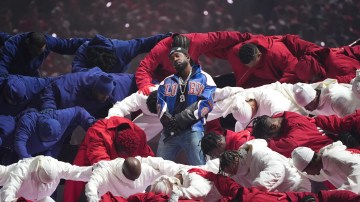History in the Bowl: How Black Culture Shaped and Continues to Influence the Super Bowl Halftime Show
The Super Bowl Halftime Show is one of the most-watched musical performances in the world, a spectacle that blends entertainment, culture, and history

The Super Bowl Halftime Show is one of the most-watched musical performances in the world, a spectacle that blends entertainment, culture, and history.
Over the years, Black artists and cultural icons have played a defining role in shaping the halftime show into the phenomenon it is today. From groundbreaking performances to the infusion of hip-hop, R&B, and gospel influences, the show has become a stage where Black artistry, creativity, and influence shine on a global scale.
The early Super Bowl halftime shows were far from the star-studded productions we see today. Marching bands and novelty acts dominated the performances until the 1990s, when the NFL realized the potential of making halftime a major entertainment event. The game-changing moment came in 1993, when Michael Jackson took the stage, delivering a performance that set the standard for the modern halftime show.
His presence not only transformed the halftime format but also highlighted the power of Black artists in elevating the event’s cultural significance.
Following Jackson’s groundbreaking performance, more Black artists began to take center stage, leaving an indelible mark on the Super Bowl and all who watched. From Diana Ross’s grand helicopter exit in 1996 to Beyoncé’s electrifying 2013 performance, which paid homage to HBCU culture and Black empowerment, these moments have gone beyond music, making powerful cultural and political statements.
Beyoncé’s 2016 return, where she performed “Formation” alongside dancers dressed in Black Panther-inspired outfits, sparked national conversations on race, activism, and Black pride, proving that the Super Bowl stage is more than just an entertainment platform—it’s a moment in history. The influence of hip-hop and R&B – deeply rooted in Black culture – became impossible to ignore.
Rap music, however, was sidelined from mainstream Super Bowl performances. After Jay-Z and his company, Roc Nation, began a long-term partnership with the NFL in 2019, rap music finally had an advocate. In 2022, Jay-Z’s impact on the NFL was evident as Dr. Dre, Snoop Dogg, Mary J. Blige, Kendrick Lamar, Eminem, and 50 Cent took the stage, delivering the first-ever halftime show dedicated entirely to hip-hop. It was a historic acknowledgment of the genre’s global dominance and its place in shaping American culture.
Beyond individual performances, Black culture’s impact on the Super Bowl Halftime Show extends to fashion, choreography, and visual storytelling. These moments have become cultural milestones. From Prince’s unforgettable 2007 performance in the rain to Rihanna’s 2023 return to music with an all-red aesthetic that celebrated pregnancy and power. The show’s production style, stage design, and dance influences frequently borrow from Black artistic traditions, whether it’s the precision of step routines, the energy of street dance, or the gospel-infused vocal arrangements that give performances their emotional weight.
From Michael Jackson’s game-changing performance to the long-overdue embrace of hip-hop, Black culture has shaped the Super Bowl Halftime Show into the spectacle it is today. As the show continues to evolve, it remains a powerful testament to the enduring influence of Black artistry in shaping global pop culture.



